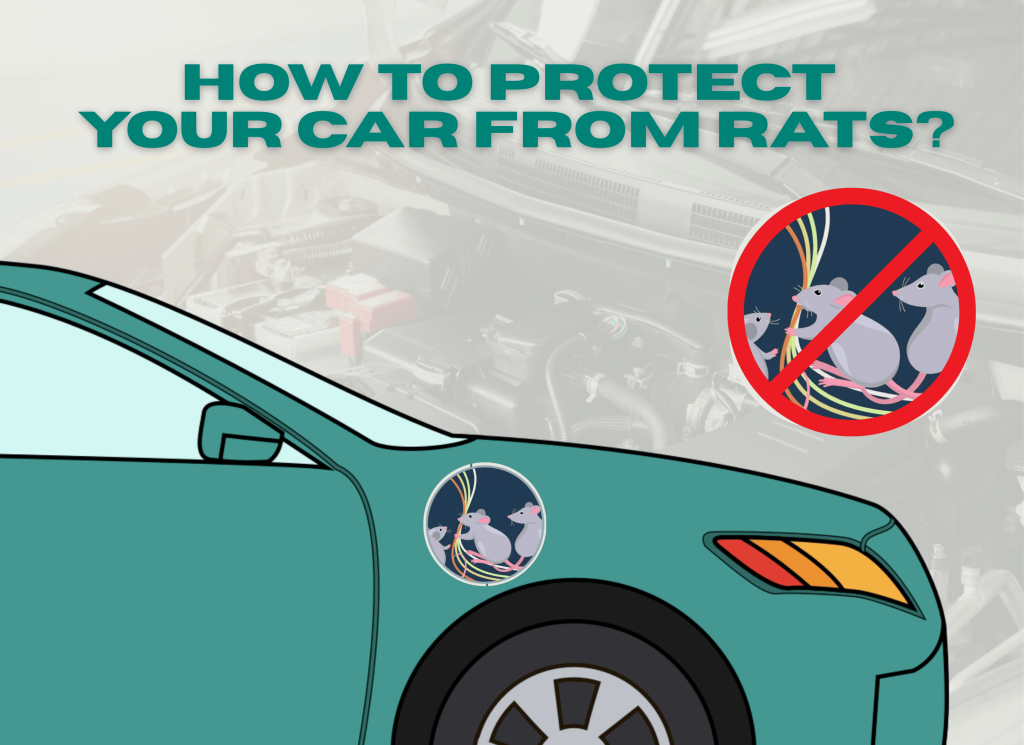Picture this: you’re ready to hit the road, the engine hums to life, and then—crunch—you hear a strange noise beneath the hood. You pop the bonnet and discover a chewed-up wire, a shredded seat, or worse, a rat nest. The devastation left by these unwanted critters can be both frustrating and costly. But how to protect your car from rats isn’t as difficult as you might think. With a few clever strategies and proactive steps, you can keep your vehicle free from these sneaky invaders. Rats are more than just a nuisance; they can cause significant damage to your car’s wiring, upholstery, and insulation. And with their ability to squeeze into tiny spaces, preventing their entry can seem like a daunting task. However, understanding why rats are attracted to your car and taking simple measures to deter them can save you a lot of hassle. In this guide, we’ll explore actionable tips and ingenious solutions to keep your car safe from these pesky rodents. Let’s dive into the world of rodent-proofing your ride and discover how to keep your vehicle rat-free all year round!
Why Do Rats Enter Cars?
Rats are opportunistic creatures, always on the lookout for shelter and food. Unfortunately, your car can become an attractive target. But why do rats enter cars in the first place? Here are some common reasons:
1. Search for Shelter
Rats are constantly seeking safe, dark places to nest. Cars, especially those parked in secluded areas or garages, offer a perfect refuge from predators and harsh weather. The warmth of the engine or the secluded spots under the hood can make your vehicle seem like an ideal home for a family of rats.
2. Food Source
Just like any scavenger, rats are drawn to food. Crumbs, spilled snacks, or even forgotten take-out can tempt them to sneak into your car. Once inside, they may stay for the long haul if they find a steady food source.
3. Chew on Wires and Insulation
Rats have a constant need to gnaw on things to keep their teeth sharp and manageable. Your car’s wires, upholstery, and insulation are no match for their sharp teeth. They can cause significant damage, making it essential to know how to protect your car from rats before they wreak havoc.
What issue Can Rats Cause in Your Car
Rats in your car are more than just an inconvenience; they pose serious dangers that can leave your vehicle in disrepair and your wallet lighter. Here’s why it’s critical to address the presence of these pesky invaders promptly.
1. Wiring and Electrical Damage
Rats are notorious for chewing on anything they can get their teeth on, and car wiring is no exception. The insulation around wires, crucial for the proper functioning of your vehicle, is an irresistible target. Once chewed through, wires can short-circuit, leading to expensive repairs. This damage can also result in safety issues, like faulty brakes or malfunctioning lights.
2. Health Risks
Rats are carriers of numerous diseases, including hantavirus, leptospirosis, and salmonella. These infections can spread through their urine, droppings, or even direct contact. If rats have been inside your car, especially in areas like the air vents or the engine bay, you could inadvertently expose yourself to these health hazards. Proper cleaning and decontamination become crucial to protect your health.
3. Structural Damage
Aside from wiring, rats will often chew through the car’s insulation, rubber seals, and upholstery. The long-term effects can lead to compromised structural integrity and uncomfortable driving conditions. Not only does this cause discomfort, but it also reduces the overall lifespan of your vehicle.
4. Odors and Nests
A rat infestation often leads to unpleasant odors from urine and decaying food, or worse, a rat carcass trapped in hard-to-reach places. These smells can linger and are difficult to remove. Additionally, rats tend to build nests using the soft materials inside your car, creating an even greater mess to clean.
Understanding these dangers emphasizes the importance of knowing how to protect your car from rats. By taking preventative steps, you can avoid costly repairs, health risks, and long-term damage to your vehicle.
Top 12 Tips to Keep Cars Safe from Rats
Rats can wreak havoc on your car, causing everything from wiring damage to unpleasant odors. Preventing these invaders from setting up camp in your vehicle is crucial. Here are 12 practical tips to help keep your car safe from rats.
1. Park in Well-Lit Areas
Rats tend to avoid areas with high human activity. Parking your car in a well-lit, busy location makes it less appealing as a potential hiding spot. This simple measure can significantly reduce the risk of attracting these unwelcome guests.
2. Seal All Entry Points
Rats are excellent at squeezing through tiny gaps. Inspect your car for any cracks or openings, especially in the engine bay, under the hood, and around the tires. Sealing these potential entry points is a crucial step in how to protect your car from rats.
3. Keep Your Car Clean
A clean car is less likely to attract rats. Make sure to regularly vacuum crumbs, clean spilled food, and remove any trash from inside the vehicle. Even small remnants of food can be enough to lure them in.
4. Store Your Car in a Garage
Whenever possible, park your car in a sealed garage. A closed space not only protects your car from the elements but also limits a rat’s access. If a garage isn’t available, consider using a car cover to add an extra layer of protection.
5. Use Rat Repellents
Natural repellents, like peppermint oil or eucalyptus, can be a strong deterrent. Soak cotton balls in these oils and place them around the car’s interior, engine bay, or under the car. Rats dislike the strong scent, making it a useful tactic.
6. Install Rodent Traps
Setting traps around your parking area is a good way to catch any potential invaders before they make their way into your car. Make sure to check the traps frequently to avoid any unpleasant surprises.
7. Regularly Inspect the Engine Bay
The engine bay is a favorite nesting spot for rats. Regularly check for signs of activity, such as droppings or shredded materials. A quick inspection can help you spot issues early, preventing more severe damage.
8. Use Steel Wool to Block Entry
For any gaps or holes that are difficult to seal, use steel wool. Its tough texture makes it an excellent material to block rats from chewing through the openings. It’s an effective, low-cost solution for securing vulnerable areas.
9. Install Mesh Screens
Install mesh screens over ventilation ducts and air intake areas. These screens allow air to flow while preventing rats from sneaking in. It’s a simple and inexpensive way to protect your car’s inner workings.
10. Clear the Area Around Your Parking Spot
Rats love to nest in tall grass, piles of leaves, and nearby clutter. By clearing the area around your parking space, you remove potential hiding places for rodents, making it less likely for them to target your car.
11. Consider Ultrasonic Repellents
Ultrasonic devices emit a high-frequency sound that rats find uncomfortable, driving them away. These devices can be plugged into your car or placed nearby to create a barrier that repels rodents effectively.
12. Check for Damage Regularly
Make it a habit to check your car for signs of rat activity. Look for gnaw marks, droppings, or nests. Early detection can save you from costly repairs and help you address potential issues before they escalate.
By implementing these 12 tips, you’ll be well on your way to keeping your car safe from rats. Remember, prevention is key when it comes to how to protect your car from rats, and staying vigilant will help keep these pesky rodents at bay.
When it comes to how to protect your car from rats, there are several myths that can lead to ineffective solutions or wasted effort. Understanding what doesn’t work is just as important as knowing the right approach.
1. “Rats Only Like Old Cars”
This is a common misconception. Rats are not picky about the age of a car; they’re more concerned with food, shelter, and safety. Whether your vehicle is brand new or decades old, rats can easily target it if the environment is favorable.
2. “Mice Traps Are Enough”
While traps can help, they’re not a comprehensive solution. Simply setting traps around your car won’t necessarily prevent rats from entering. Without addressing entry points, the problem may persist. A multifaceted approach is essential to how to protect your car from rats.
3. “Peppermint Oil Will Solve Everything”
Peppermint oil is often touted as a rat deterrent, but it’s not a foolproof solution. While it can help to an extent, relying solely on this method won’t guarantee results. It’s best to combine it with other preventative measures for maximum effectiveness.
4. “Cars in Garages Are Safe”
Even parked in a garage, rats can find their way into your car. A garage doesn’t automatically make your vehicle rat-proof. Ensure the space is sealed and free of potential nesting spots to truly protect your car.
Debunking these myths will help you focus on the real strategies for how to protect your car from rats and keep your vehicle safe.
Conclusion
In conclusion, keeping rats away from your car requires a combination of vigilance, preparation, and proactive measures. By understanding how to protect your car from rats, you can prevent costly damage and avoid the health risks associated with rodent infestations. Whether it’s sealing entry points, maintaining a clean vehicle, or using repellents, taking consistent action will help safeguard your car. Remember, these creatures are resourceful, but with the right strategies in place, you can outsmart them and keep your vehicle safe from harm. Stay alert, and your car will remain rat-free and ready to hit the road.

